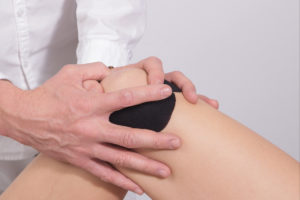Each year, almost seven million Americans visit hospital emergency rooms because of knee pain. A combination of a traumatic injury and chronic overuse causes most of these injuries, whether they are serious or non-serious. For example, Harry might play tackle football for years, sustain repeated blows on his knee, and suffer no ill effects. But that trauma usually weakens the knee, making Harry more susceptible to overuse injuries later in life.

In terms of the pain, many knee injuries feel about the same, especially in the first few hours or days. But they are definitely not all the same in terms of treatment and recovery. So, it’s important to know the facts so that you neither panic over what seems to be a serious injury nor ignore a potentially serious problem that will probably get worse.
Knee Bursitis
The knee has four tiny bursa sacs, two above the joint and two below it. Whereas cartilage serves as a shock absorber between bones, these fluid-filled sacs cushion the area between not only the bones, but also the muscles, tendons, and skin. A combination of degenerative use and a sudden blow often inflames these sacs. That causes mild discomfort, even when you are at rest and some loss of motion.
If you have a fever as well as pain in the knee, you probably have an infected bursa sac, and you need to see a doctor. Otherwise, bursitis usually goes away if you limit kneeling, squatting, and other such movements.
Tendonitis
Patellar tendonitis, the most common form of knee tendonitis, is an inflammation of the tendon which connects the patella (kneecap) with the tibia (shinbone). Pain usually centers on the front of the kneecap. At first, the discomfort is rather mild, but it gets progressively worse.
The RICE method is the best way to reduce inflammation in this tendon. Here are the specifics:
- Rest: Stay off the knee as much as possible, and use crutches when you need to move around.
- Ice: Twenty minutes of cold therapy three or four times a day will reduce swelling and also relieve discomfort. If the area turns white, you are over-icing the injury.
- Compression: Some tight KT Tape or another compression wrap will support the kneecap while the tendon heals and also control inflammation. A knee compression brace is even better.
- Elevation: It may be very uncomfortable at first, but raise the knee above your heart. Only lower it occasionally to do some light range-of-motion exercises and allow the blood to circulate.
This approach usually works for another tendon, muscle, and ligament injuries as well.
Tears
Low-grade tears often heal by themselves has given rest, ice, compression, and elevation. Avoid taking painkillers if possible because they may give you a false sense as to your recovery. More extreme tears sometimes require surgery and/or physical therapy. Some common tears include:
- Lateral Collateral Ligament Tears: Your LCL is one of the main stability ligaments in the knee. It runs along the outside of the joint. Because of the location, LCL tears usually aren’t as serious as ACL tears. LCL injuries often get better when patients use the RICE method and perhaps get some physical therapy.
- Anterior Cruciate Ligament Tears: The ACL, which runs diagonally across the knee, also stabilizes the joint. ACL tears are most commonly associated with contact sports, but improper mechanics may cause these injuries as well. Most people hear their knees pop when their ACLs tear and the pain is localized near the ACL.
- Meniscal Tears: These cartilage tears often produce popping sounds as well, but instead of instant, near-debilitating pain, the discomfort steadily gets worse over two or three days. If the RICE method doesn’t improve the injury significantly in a couple of weeks, physical therapy or surgery may be appropriate.
The Medial Collateral Ligament (MCL) is the other major ligament in the knee, and it’s also somewhat prone to overuse/trauma injuries.
Bone Injury
If you have the complete inability to support weight on the affected leg, do not hear a pop, and hear cracking noises when you flex the knee, the patella bone is probably dislocated. A doctor needs to examine the injury with an X-Ray and probably an MRI to determine the extent of the injury.
Surprisingly, these injuries don’t always require surgery, although that is generally true. Sometimes, a combination of stretches, compression sleeves and supportive braces will gently push the bone back into alignment. Recovery time varies as well, from several weeks to several months.



